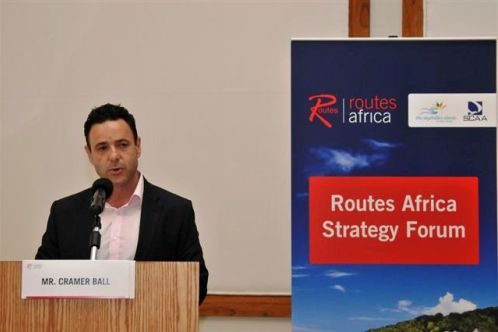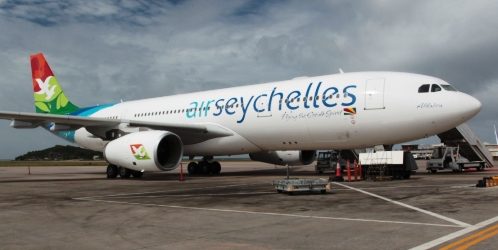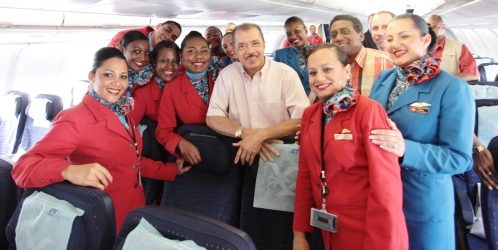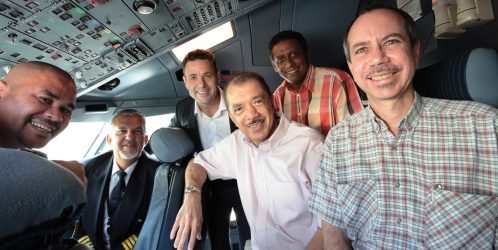It is a brand new era at the small Indian Ocean national carrier, Air Seychelles, as its new shareholder, Etihad Airways, begins to influence its development, with a new Chief Executive Officer, a new fleet of aircraft a new outlook that could completely revolutionise the visitor profile to the idyllic Seychelles archipelago.
When Etihad Airways acquired a 40 per cent shareholding in Air Seychelles at the start of this year it represented a marked change for a carrier that had struggles to make profits during its previous years of operations. With just a small fleet of ageing Boeing 767 models and an inefficient route network it future was uncertain, but with Etihad and the Seychelles government each investing $20 million in the state-owned airline and the Abu Dhabi-based airline also providing a $25 million loan to help Air Seychelles meet working capital requirements and support network development, its future looks much brighter.

Upon completion of the Etihad investment on February 1, 2012, a number of senior managers from Etihad were seconded to the Seychelles to undertake a restructuring of the carrier and align and synchronise the business with its Gulf partner, leveraging on the Etihad brand and resources to help reduce costs and boost efficiencies. The most senior of these appointments was Cramer Ball, formerly Etihad’s General Manager for Asia, Pacific and Australasia, as Chief Executive Officer and The HUB sat down with the hard-talking Australian during Routes Africa this week to learn more about the plans for the carrier.
When Cramer first joined Air Seychelles the carrier had just completed a major rationalisation under the regime of its predecessor Bram Stellar, with its network being cut to just a handful of international routes. “This had been a necessity for the carrier,” explained Cramer. “For far too long it had been hemorrhaging money and the increase in fuel price in particular had taking its toll on what was already an inefficient model. Air Seychelles lost its pants and its shirt flying to Europe. There was no way it would have been able to sustain an operation as the figures show it would have needed to double fares to make money and that simply was not possible with Emirates Airline and Qatar Airways competing for the same traffic via their Dubai and Doha hubs.”
The airline now focuses on just three international routes; Johannesburg and Mauritius, which have been key to its network for a long period of time; and Abu Dhabi, a new route to link into the network of Etihad Airways across the world. “It is no longer about direct flights it is about access to markets and frequency,” said Cramer. “By feeding into the hub of Etihad we are now able to provide services to a number of additional destinations in a more efficient manner.”
Tourism is the strongest driver of the Seychelles economy and total visitor arrivals so far this year are seven per cent up on 2011; growth last year was up around eight per cent over 2010. Despite the loss of non-stop links to destinations across Europe the continent remains a key area for traffic in and out of the country. The top feeder markets in Europe include France, Germany, Italy, Belgium and the UK, although there is also a growth in non-traditional markets, including Russia and the Gulf Cooperation Council (GCC), according to Cramer. “Our codeshare with Etihad has allowed us to reenter these markets and an increase in the frequency of flights into Abu Dhabi means we have a greater number of options for the traveller,” he said.

“The Seychelles is truly a nation of the world, marrying many cultures including French, African, Indian and Chinese to create a distinctly Seychellois’ Creole spirit. With the increasing numbers of visitors to the islands, there is a corresponding increase in demand for air support. We are re-positioning our brand to take advantage of this. We want to be recognised as one of the top carriers in the Indian Ocean,” added Cramer. In fact the arrival of its first Airbus A330-200 means it is currently the only airline to offer a full lie-flat Business Class option into the region. The aircraft was delivered just days ahead of Routes Africa and entered regular scheduled service this week following some modifications.
“The change of our fleet is a key part of our new business strategy,” explained Cramer. During the first five months of his tenure he has successfully returned the carrier’s Boeing 767s to their owners. “As those of you in the business will be aware, this is not an easy job, but we have been able to leverage on the experience and skills at Etihad to make this happen,” he added. Ahead of the arrival of its first aircraft, a former Jet Airways, A330-200, Air Seychelles has been utilising an Etihad A330-200 on its own HM-operated flights between Abu Dhabi and Johannesburg, enabling it time to type train its own flight and cabin staff to fly the new widebodied model.
Air Seychelles is also wet-leasing an Airbus A320 from Etihad to fly its route from Seychelles to Mauritius. “This route used to be flown with a 767, an aircraft that was too large, but with limited fleet capacity it was previously the only option to keep connectivity between the two markets. The A320 is the right-sized aircraft for this route and we are experiencing really healthy loads,” said Cramer.
The arrival of the A330-200 on July 5, 2012 marks a key milestone in the Air Seychelles story. The aircraft has been named Aldabra in honour of Aldabra Island, a UNESCO World Heritage Site and one of Seychelles' most remote and pristine islands. Aldabra, the world's largest raised coral atoll, is surrounded by a pristine marine environment, uninhabited and known for its distinctive fauna including the Aldabra Giant Tortoise.
"This marks a historic moment, a turning point towards a brighter future. The A330 aircraft is not only younger and more fuel-efficient, but it also boasts excellent new product and services never before seen at Air Seychelles. To see our pilots and cabin crew again working proudly in uniform also shows how far Air Seychelles has come in a relatively short time. With our colourful aircraft livery and world-class service, we will bring the Creole spirit to every destination we fly too," said Cramer.

The A330-200 displays the new corporate livery of Air Seychelles and a revised company approach defined by its vision and mission statements and operational values. “While we want to preserve the integrity of the Air Seychelles brand, with its iconic Creole spirit, we are also elevating the business model. Our new vision ‘to be a profitable, high-quality airline’; our revised mission of ‘delivering to our guests quality service with unique Creole warmth and our new company values of ‘Honesty, Team Spirit, Positive Attitude, Respect and Caring’ have been forged though consensus of management and leaders throughout the company. This provides real, measurable and achievable goals that all members of staff contribute to. Our old vision was very general and our mission statement included a total of four dot points making it long and unmemorable. The values were 68 words long and did not focus on any core aspects,” explained Cramer.
After a hectic first five months at the carrier, what will the remaining five months of the year bring? After reorganising its international operations, it will be the turn of its domestic activities. “In the past the airline was operated as two distinct ventures – international and domestic. We will bring these together as they are intrinsically linked and make better use of our domestic fleet to perhaps introduce sigh-seeing flights etc for visitors alongside our regular transfers to other islands,” said Cramer. The airline currently operates a single 32-seat Shorts 360 and four 19-seat DHC-6 Twin Otters, but is likely to retire the Shorts to focus on the single Twin Otter type. “We are currently undergoing a domestic fleet review. By end of year, we will finalise a long-term strategic plan to shape our future domestic operations,” added Cramer.
There will be further growth in the international network as flights to Johannesburg are doubled from two to four a week, while the arrival of a second A330-200 in January 2013 will enable flights to Beijing to be added. Cramer is reluctant to commit on potential growth markets for Air Seychelles and instead focuses on the point that partnerships are key to the airline’s evolution.
“We now have four flights to the Abu Dhabi hub. Together with our codeshare on Etihad's additional four weekly flights, we now have sub four-hour connectivity to 737 flights per week and two way connectivity to 35 destinations worldwide, including 11 major European cities. This is compared with a previous network of four direct points in Europe served with six weekly flights,” he said.
“Partnerships are the key to success of the business. Individually, airlines are subject to constraints, economic, political or regulatory in nature. Through partners, we can optimise synergies and take advantage of economies of scale. However, this is not all about airlines as we will be looking to work closely with the Seychelles Tourist Board to try and bring more visitors to the islands. There is only so much we can do to stimulate the market with low-fares and we need local partners at some of the three and four star establishments that don’t currently have the logistics to buy into the product we are developing,” he added.

The partnership between Air Seychelles and Etihad is already bearing fruit, says Cramer. “By leveraging its brand and resources we have renegotiated catering contracts from Seychelles and Johannesburg which will save Air Seychelles nearly $300,000. Etihad’s expertise has allowed us to complete our fleet rollover, while joint negotiations mean we will save significantly on fuel costs. We have made considerable savings throughout the business, even on the sourcing of printer cartridges for the business.” he said.
It has been a remarkable turnaround for Air Seychelles in such a short period of time and a very bold path to follow for the local Government. The country’s President Michel has been hailed for his foresight, courage and vision in repositioning the national airline ahead of the great turmoil Indian Ocean airlines find themselves faced with. By giving Air Seychelles a head-start and finding it a strong and excellent strategic partner the airline’s management believes the worst is behind it.
“We will preserve the integrity of the Air Seychelles brand. Air Seychelles has come to be known for flying the Creole spirit, and we’ll continue to do that. We don’t want to give our guests something unrecognisable, we just want to give them an improved version of the brand they already know and love,” concluded Cramer.





